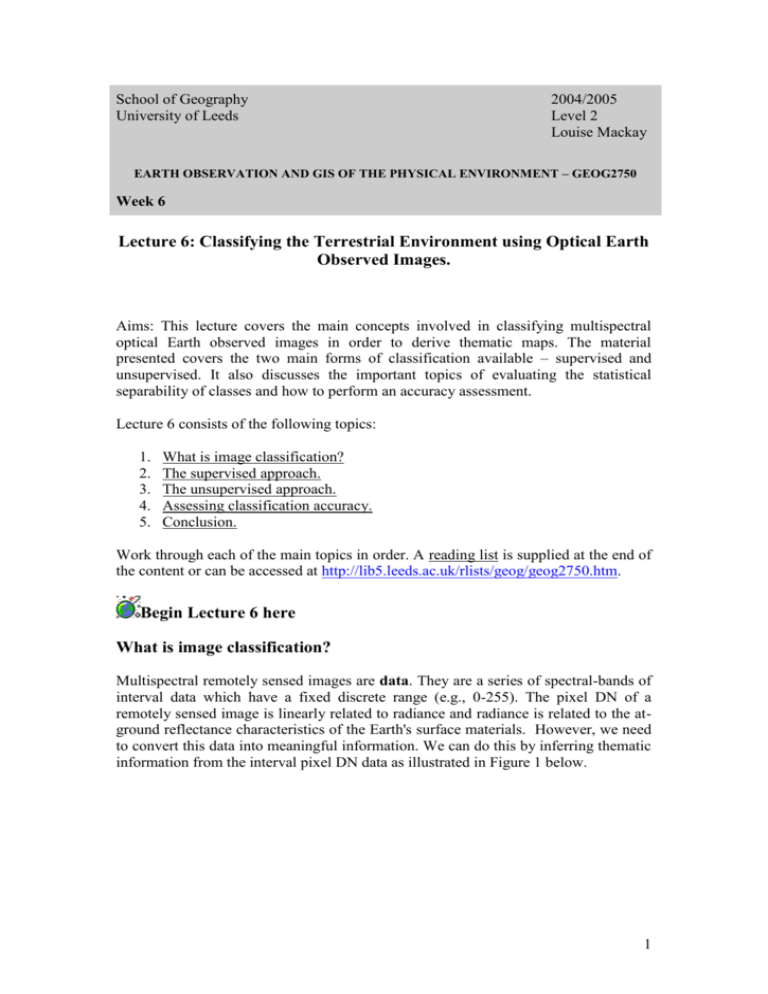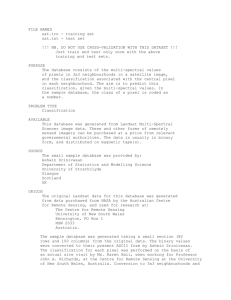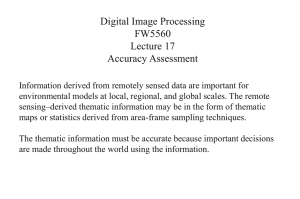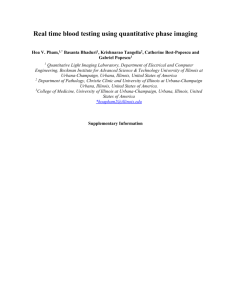Lecture 6: Classifying the Terrestrial
advertisement

School of Geography University of Leeds 2004/2005 Level 2 Louise Mackay EARTH OBSERVATION AND GIS OF THE PHYSICAL ENVIRONMENT – GEOG2750 Week 6 Lecture 6: Classifying the Terrestrial Environment using Optical Earth Observed Images. Aims: This lecture covers the main concepts involved in classifying multispectral optical Earth observed images in order to derive thematic maps. The material presented covers the two main forms of classification available – supervised and unsupervised. It also discusses the important topics of evaluating the statistical separability of classes and how to perform an accuracy assessment. Lecture 6 consists of the following topics: 1. 2. 3. 4. 5. What is image classification? The supervised approach. The unsupervised approach. Assessing classification accuracy. Conclusion. Work through each of the main topics in order. A reading list is supplied at the end of the content or can be accessed at http://lib5.leeds.ac.uk/rlists/geog/geog2750.htm. Begin Lecture 6 here What is image classification? Multispectral remotely sensed images are data. They are a series of spectral-bands of interval data which have a fixed discrete range (e.g., 0-255). The pixel DN of a remotely sensed image is linearly related to radiance and radiance is related to the atground reflectance characteristics of the Earth's surface materials. However, we need to convert this data into meaningful information. We can do this by inferring thematic information from the interval pixel DN data as illustrated in Figure 1 below. 1 Figure 1: An illustration of the purpose of classification: inferring from a multispectral image to a thematic map. One form of remote sensing inference involves using the multispectral values of a pixel to statistically estimate its thematic land cover type. We will now look at the importance of image classification and the approaches commonly used to classify remotely sensed data. Why is Classification necessary? Classification allows us to assign meaning to image pixels to produce invaluable thematic data sets of information that can used in further GIS analysis. For example the UK Centre for Ecology and Hydrology Land Cover Map 2000, is a 27 class land cover map of the entire UK derived from Landsat ETM data at 25m spatial resolution. See http://www.ceh.ac.uk/data/lcm/LCM2000.shtm. An extract of this land cover map is illustrated in Figure 2 below. Figure 2: An extract of the LCM2000 land cover map. 2 Classification is invaluable for local, regional, continental and global monitoring of the biosphere. The potential range of applications for classified Earth observation images is large. Here we can see an example of a global land cover data set (Figure 3 below); from such a data set we are able to extract information useful for many further applications: Environmental character assessment; Environmental protection; Forestry research and management; Global biome monitoring; Land use planning; Sensitive habitat monitoring; Vegetation succession; Figure 3: A global land cover data set. Continental land cover dynamics; Desertification, etc. Two types of statistical classification are commonly employed in Earth observation: 1. Supervised Classification: An operator recognises the themes present in the image. Using these themes the software attempts to assign all pixels to one of the recognised themes. This results in a labelled map where each pixel is assigned to a theme. 2. Unsupervised Classification (Segmentation): No operator recognition of themes present in the image. The software attempts to collate alike pixels into distinct groups or clusters. This 3 results in a segmented/clustered ordinal image that is not labelled. Labelling needs to be done to assign themes to clusters. Conceptually classification involves considering a multispectral image to consist of N-dimensional feature space, where each axis corresponds to a spectral-band, and partitioning this feature space into distinct non-overlapping regions that relate to separate land cover types. For example, looking at the multispectral Landsat image below left, if we partition this multispectral image into feature spaces for bands 3/4 and bands 4/5 (below right) we can see that regions exist that relate to the land cover types occurring in this particular scene. Looking at the main land cover types in the Landsat image and with your knowledge of the Landsat bands, can you explain the shape of the feature space plots? Action point: Look up and define feature space and their usage in classification, either using the references cited or through your own library/literature search. Figure 4: Landsat multispectral image and example feature space plots. The supervised approach Supervised classification can be characterised in four general steps: 1. Recognising the thematic classes that are present in the multispectral image to be classified. 2. Selecting a series of training areas or single pixels which characterise the multispectral (DN) variability of each thematic class. 3. Using the training areas/pixels to characterise the statistical multispectral (DN) distribution of each thematic class. 4 4. Using the generated statistics to assign each multispectral pixel to one of the recognised themes present in the scene. These steps will now be described in more detail. Steps 1 and 2 - recognising training classes For example, Figure 5 below is a Landsat image of Amazonian Peru, areas that are recognised (from ground data and/or map data) in the left-hand image as being of a distinct class (vegetation type) are delineated (coloured patches in the right-hand image) and used as separate training classes. Figure 5: Choosing training areas from image data. Note: The use of ground/map data is a very common and useful technique for recognition of class training areas and familiarises the user with the study area that they wish to classify. Step 3 - Statistical characterisation of training samples The 1st order statistical characterisation of a training sample for a single class involves calculating its mean multispectral vector (Figure 6 below). This involves a simple calculation of the mathematical mean of all of the training pixels in each class for each multispectral band. 5 Figure 6: Mean vector calculation. The 2nd order statistical characterisation of a training sample for a single class involves calculating its covariance (matrix) around its mean vector (Figure 7 below). This involves calculation of the mathematical variance of the training pixels around the mean vector for and between each multispectral band. Figure 7: Calculation of the mean vector and covariance matrix for use in statistical classification. Step 4 - using the generated statistics to assign each multispectral pixel In supervised classification several algorithms can be used for this step, in this lecture we will address the two most common algorithms used: Minimum Distance and Maximum Likelihood. 6 The Minimum Distance algorithm This algorithm assigns a pixel to a class on the basis of its proximity to the class mean vectors: The distance (d) from a given pixel and each class mean vector (x) is most commonly calculated using N-dimensional Euclidean distance: Action point: define Euclidean distance. This would then give a feature space that closely resembles our example below. 7 When spectral distance is calculated for all possible values of c (all possible classes), the class of the candidate pixel (unclassified pixel to be assigned) is assigned to the class for which the spectral distance (d) is the lowest. In terms of feature space, candidate pixels are assigned to a class if they fall within the class feature space boundaries (as shown above). The Minimum Distance algorithm has been applied here on the Landsat 5 TM multispectral image of NW England and North Wales (Figure 10 below left) to produce a 2-class classification (water or land) (Figure 11 below right). Figure 10: Landsat image Figure 11: Minimum distance classification The advantage of the Minimum distance algorithm is that every pixel is assigned to a class (producing no unclassified pixels) and it is very quick to compute. However, the disadvantage of this approach is that is does not account for class variability: for example, a class with high variance such as an urban land cover may incorrectly classify outlying urban pixels are urban and a class with low variance such as water may be overclassified by pixels close to the water class mean. 8 The Maximum Likelihood algorithm This algorithm assigns a pixel to a class on the basis of its probability of belonging to a class whose mean and covariance are modelled as forming a normal distribution in multispectral feature space (Figure 12 below). Figure 12: Maximum likelihood feature space illustration. Although the Maximum Likelihood algorithm is a parametric classifier - it is quite possible for the resulting multivariate normal distributions derived from training pixels to overlap. When this occurs the feature space decision boundaries take a quadratic form (curved solid lines below right) and are proportional to the covariance exhibited by each class (look at the two classes C1 and C2 in Figure 13 below). Figure 13: Class distributions for C1 and C2 with class overlap resulting in quadratic decision boundaries in feature space for the Maximum Likelihood algorithm. 9 The Maximum Likelihood algorithm has been applied here on the Landsat 5 TM multispectral image of NW England and North Wales (Figure 14 below left) to produce a 2-class classification (water or land) (Figure 15 below right). Figure 14: Landsat image Figure 15: Maximum Likelihood classification The advantage of the Maximum Likelihood algorithm is that it takes the variability of the classes into account by using the covariance matrix and in our case is the most accurate algorithm when using the Erdas IMAGINE image processing software. However, the computation time of this equation is long and it tends to overclassify classes with large spectral variabilities. As the algorithm is parametric it relies on the data in each band exhibiting a normal distribution (which may not be the case for spectrally variable land cover types). When comparing the use of the Minimum Distance and Maximum Likelihood algorithm for classifying the Landsat image (for two broad land cover classes) we can see the difference in classification of the water and land (Figure 16 below). In this instance the Minimum Distance classification classifies shallow tidal areas as water and the Maximum Likelihood classification does not. 10 Figure 16: A comparison of the minimum distance algorithm and the maximum likelihood algorithm for the classification of a multispectral Landsat image. The unsupervised approach On occasions it may not be possible to perform supervised classification for various reasons: (i) No map information or knowledge of the area exists to select class training samples. (ii) A high degree of ambiguity exists in recognising classes purely on the basis of the image data alone. In such circumstances it is often still desirable to partition the image into logical groups of pixels that are related to the same land cover. This still requires some means by which the multispectral image can be statistically partitioned. This can be done using unsupervised classification or feature space clustering. A common unsupervised segmentation approach - K-means clustering K-means clustering is a simple unsupervised segmentation approach which works in the following manner: 11 1. Seeding (randomly) cluster mean vectors in feature space. 2. Allocates all pixels to one of the cluster mean vectors using Euclidean distance. 3. Updates the clusters mean vector on basis of the assigned pixels. 4. New cluster mean vectors used in second allocation, runs for N-iterations. This unsupervised approach does need initial human parameterisation: the number of clusters are fixed and must be specified by the user; the convergence criteria must be set at some minimum change in clusters mean vector location in feature space; and the number of iterations to run must be set if convergence is not achieved. A pixel cluster map is produced from the K-means clustering approach, but final meaning (classes) must then be assigned by the user. A K-means clustering algorithm has been applied here on the Landsat 5 TM multispectral image of NW England and North Wales (Figure 17 right). Figure 17 has been produced by a 10 cluster K-means segmentation using 5 Landsat bands, in this instance convergence has not been achieved after 25 iterations. Figure 17: K-means cluster of a Landsat TM image. In Figures 18 and 19 (below) we can see the results of different initial user settings for a K-means clustering approach. 12 Figure 18 - 5 clusters, high convergence set, 25 iterations Figure 19 - 5 clusters, low convergence set, 10 iterations Action point: looking at the three K-means approaches do you see a particular clustering approach that maps some features better than others? Note your answers for future reference. Note: choosing a classification scheme is a decision you may have to make as a user depending on your informational requirements. Action point: Research and note the advantages and disadvantages of the K-means clustering approach. A random sample of students will be emailed to place their findings on the discussion board. Assessing classification accuracy A typical application led classification can be summarised as a classification chain: 1 – The recognition of the themes/classes present. 2 - Selection of training pixels for each theme/class. 3 - The statistical description of each theme/class. 4 - An assessment of their statistical separability. 5 - Selection and application of the classifier. 6 - An assessment of the accuracy of the resulting classified map. 13 This chain is represented in Figure 20 below. Figure 20: A representation of the classification chain. Assessments of class statistical separability and of the accuracy of the final map are both important parts of this classification chain (yellow areas in the classification chain figure). These two points will now be introduced briefly; you are advised to expand upon this introduction from your own reading. Class Separability Analysis Class mean vectors and covariance matrices can be used to evaluate the statistical separability of the classes. Many measures exist, a popular one is divergence. The divergence measure assumes multivariate normally distributed data; a pairwise comparison matrix is derived from this measure. Although normal divergence has no upper bounds (continuous) a saturation function can be applied to give bounds of 0100, where 0 represents complete class statistical inseparability and 100 represents complete class statistical separability. For example, Figure 21 below illustrates example pairwise divergence measures between three classes. While class combinations C1/C2 and C1/C3 show high statistical separability class combination C2/C3 shows low statistical separability. Figure 21: Example pairwise divergence values for a 3-band separability analysis. 14 Accuracy Assessment Accuracy is normally assessed by taking an independent random sample of known pixels from the original image and generating a confusion matrix for the classified image. For example, Figure 22 below illustrates an example confusion matrix to assess a 3-class image classification. In this instance the overall classification accuracy is 73%, from your reading ascertain if this would be considered high classification accuracy and ascertain how the accuracy of individual classes are presented. Action point: For your practical this week, research how the omission, commission, user’s accuracy and producer’s accuracy are defined and calculated. A random sample of student’s will be emailed to place a suitable reference (web-based and library literature) to these terms on the discussion board. Figure 22: An example confusion matrix to assess the accuracy of a 3-class (Buildings, Vegetation, Soil) classification. Conclusion Image classification is the process of deriving thematic information from multispectral Earth observed images. Classification can be undertaken by two main approaches: 1. Supervised – where good knowledge of themes present. 2. Unsupervised – when unsure as to themes present. 15 Classification should always be performed with accuracy assessment to quantify the quality of the product and ideally with a careful examination of the separability of the classes. The classification approaches that we have covered in this lecture are a popular means of transforming Earth observed data sets to information for GIS applications. Why is this lecture important? This lecture demonstrates how Earth observed images can be processed in order to provide information on land cover for use in Geographical Information Systems. As such this lecture illustrates how classified Earth observed images are sources of data and information for GIS applications. Reading list: Literally hundreds of journal research papers have been written on the development of classification procedures or their application to particular terrestrial environments/applications – simply, the classification of Earth observed images is an enormous field with many journal papers concentrating on the mathematical issues of image classification. As such, it is suggested that for this week that you read one of the following introductions to the classification of Earth observed images. In particular the material by Mather (1999) is a very good introduction to the main concepts of classification. 1. Campbell, J., 1996. Introduction to remote sensing. Pages 313-345 and 375397. 2. Gibson, P., and Power, C., 2000. Introductory remote sensing: digital image processing and applications. Pages 72-82. 3. Lillesand., T., and Kiefer, R., 2000. Remote sensing and image interpretation. Pages 533-575. 4. Mather., 1999. Computer processing of remotely-sensed images. Pages 167185 and 203-209. NOTE: access the practical session 6 handout at the beginning of Week 8 from the Nathan Bodington Geog2750 practical material room prior to the Week 8 timetabled practical class. You can download the practical handout to your ISS folder, keep your downloaded practical handout document open or print off a copy for the practical session. Content developer: Louise Mackay, School of Geography, University of Leeds. 16






